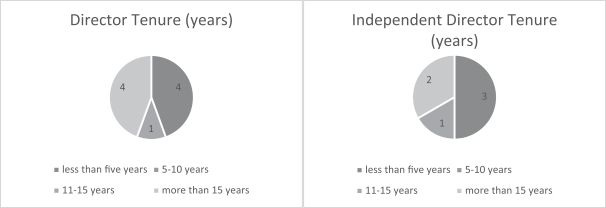IMPORTANT FACTORS REGARDING FORWARD-LOOKING STATEMENTS
Throughout this Proxy Statement, we make “forward-looking” statements, which are not historical facts, but are forward-looking statements within the meaning of the Private Securities Litigation Reform Act of 1995. These statements relate to expectations, analyses and other information based on current plans, forecasts of future results and estimates of amounts not yet determinable. These statements also relate to our current business strategies, and strategic initiatives, goals and future prospects, capital allocation plans and cash needs.prospects. These forward-looking statements are identified by their use of terms and phrases such as “anticipate,” “believe,” “continue,” “could,” “create,” “estimate,” “expect,” “goal,” “intend,” “may,” “outlook,” “pending,” “plan,” “predict,” “project,” “see,” “should,” “strategy,” “will,” “would,” and other similar terms and phrases, including references to assumptions.
Although we believe that the expectations reflected in any of our forward-looking statements are reasonable, actual results could differ materially from those projected or assumed. These forward-looking statementsFactors which may cause actual results in future periods to differ materially from current expectations include, among others: our ability to maintain our brand image and reputation; domestic and international economic or political conditions, including economic and other things, statementsevents that could negatively impact consumer confidence and discretionary consumer spending; the continuation or assumptions relating to:worsening of impacts related to the COVID-19 pandemic, including business, financial, human capital, litigation and other impacts to the Company and its partners; our expected results of operations; the accuracy of data relatingability to and anticipatedsuccessfully negotiate rent relief or other lease-related terms with our landlords; our ability to successfully negotiate or defer our vendor obligations; our ability to maintain adequate levels of futureliquidity; changes to estimates related to impairments, inventory and gross margins; anticipated cash requirements and sources; cost containment efforts; estimated charges; plans regarding store openings, closings, remodels and lease negotiations; plans regarding the relocation of the Company’s European distribution center to a new facility in the Netherlands; plans regarding business growth, international expansion and capital allocation; plans regarding supply chain efficiencies and global planning and allocation; e-commerce, digital and omni-channel initiatives; business seasonality; results and risks of current and future legal proceedings, including the investigation by the European Commission regarding the potential breach of certain European Union competition rules by the Company; industry trends; consumer demands and preferences; competition; currency fluctuations and related impacts; estimated tax rates,other reserves, including the impact of the Tax CutsCARES Act, which were made using the best information available at the time; changes in the competitive marketplace and Jobs Actin our commercial relationships; our ability to anticipate and adapt to changing consumer preferences and trends; our ability to manage our inventory commensurate with customer demand; risks related to the timing and costs of 2017delivering merchandise to our stores and our wholesale customers; unexpected or unseasonable weather conditions; our ability to effectively operate our various retail concepts, including securing, renewing, modifying or terminating leases for store locations; our ability to successfully and/or timely implement our growth strategies and other strategic initiatives; our ability to successfully implement or update information technology systems, including enhancing our global omni-channel capabilities; our ability to expand internationally and operate in regions where we have less experience, including through joint ventures; risks related to our convertible senior notes issued in April 2019, including our ability to settle the liability in cash; our ability to successfully or timely implement plans for cost reductions; our ability to effectively and efficiently manage the volume and costs associated with our European distribution centers without incurring shipment delays; our ability to attract and retain key personnel; obligations or changes to provisional estimates; results ofin estimates arising from new or existing litigation, income tax audits and other regulatory proceedings; risks related to the complexity of the Tax Reform, future clarifications and legislative amendments thereto, as well as our ability to accurately interpret and predict its impact on our cash flows and financial condition; the risk of economic uncertainty associated with the United Kingdom’s departure from the European Union (“Brexit”) or any other similar referendums that may be held; the occurrence of unforeseen epidemics, such as the COVID-19 pandemic; other catastrophic events; changes in U.S. or foreign income tax or tariff policy, including changes to tariffs on imports into the U.S.; risk of future non-cash asset impairments, including goodwill, right-of-use lease assets and/or other store asset impairments; restructuring charges; our ability to adapt to new regulatory compliance and disclosure obligations; risks associated with our foreign operations, such as violations of laws prohibiting improper payments and the burdens of complying with a variety of foreign laws and regulations (including global data privacy regulations); risks associated with the acts or omissions of our third party vendors, including a failure to comply with our vendor code of conduct or other policies; risks associated with cyber-attacks and other cyber security risks; risks associated with our ability to properly collect, use, manage and secure consumer and employee data; risks associated with our vendors’ ability to maintain the strength and security of information technology systems; and changes in economic, political, social and other conditions affecting our foreign operations and sourcing, including the impact of recent accounting pronouncements; raw materialcurrency fluctuations, global income tax rates and other inflationary cost pressures; consumer confidence;economic and general economic conditions. We do not intend, and undertake no obligation, to update our forward-looking statements to reflect future events or circumstances. Such statements involve risks and uncertainties,market conditions in the various countries in which may cause actual results to differ materially from those set forth in these statements.we operate. Important factors that could cause or contribute to such differences include those discussed under “Part I, Item 1A. Risk Factors” contained in the Company’s Annual Report on Form 10-K for the Fiscal Year Ended February 3, 2018.January 30, 2021.
8























